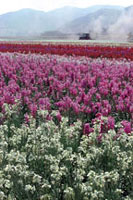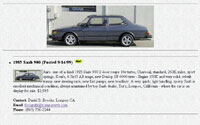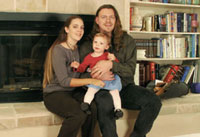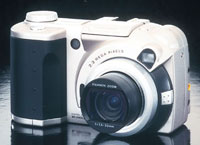Fujifilm MX-2900 Zoom
Photography as an activity
can be divided into three easily defined areas: the snapshot, with the
purpose of recording events, people, and places in our lives; the professional,
providing illustrative services from pictures for catalogs to portraits
of high school seniors; and as a serious hobby or interest, the visual
folk art of this century. Digital cameras have been produced for snapshooters
and professionals, but not for the serious enthusiast until very recently.
One of the first digital cameras to have the features demanded by and
also in the price range of a serious photo enthusiast is the new Fujifilm
MX-2900 Zoom. That this Fuji camera is different is most apparent in
the fact it looks like a camera. The feature list, however, is quite
similar to many of the recent crop of 2 plus megapixel digital cameras
in the under $1000 price bracket. Its serious nature is in the details. |
|||
The serious side of the Fujifilm
MX-2900 is in the controls provided to use the camera manually or semiautomatically.
First of all, similar to many 35mm SLRs there is a dial on top which has
several modes, including automatic and manual shooting, setup to set the
primary controls like sharpness and recording quality and flash on/off,
etc., playback, self-timer, and PC for connection to a computer. With
the dial set on manual the lcd screen provides very direct access using
a four way control toggle button array to its right. The LCD displays
white balance offering auto, daylight, shade, tungsten, etc. settings;
exposure compensation adjustment; aperture or shutter priority and full
manual control of exposure; flash mode including built-in or external;
selection of metering mode between spot, average, and multi; and the selection
of single or continuous shooting modes. Other "serious" features
include the ability to use 43mm filters, as well as an effective 28mm
wide angle accessory lens. |
|||
Before getting really "serious" with the MX-2900, I did some further tests with the exposure and white balance on automatic but with sharpness turned up a notch, and at the finest quality level of JPEG compression. I happen to live in an area where flowers are commercially grown in open fields for seed as well as for sale to the cut flower markets. For testing color response and sharpness, as well as lens distortion, these fields are ideal subjects. After downloading I was again impressed by the consistency and accuracy of the MX-2900's automatic exposure and white balance controls. In addition, I further established that what one reader thought was a weakness of digital cameras is not true; they do record various shades of purple quite richly and accurately. |
|||
My final, and most crucial, shooting trial of the MX-2900 was using it with multiple electronic flash studio lighting. My subjects were a family, the stepson, daughter-in-law, and 2-year-old granddaughter of a dear friend--the kind of subject I almost never photograph, a family portrait at home. I set up three lights, a shoot-through umbrella main light, a soft flood fill, and a background light. I set the MX-2900 at f/8 for 1/90 sec, and adjusted the flash light level to match measuring the illumination level with a flash meter. (I also shot a roll of color negative film as back-up). I only took a dozen or so shots with the MX-2900 before the 2-year-old had had enough. After downloading, and finding one out of three where all my subjects had a nice expression, I printed the best with an Epson Stylus Photo 1200 on letter-sized photo paper. |
|||
After tweaking the color balance
a bit in Photoshop the image looked good, so why not see how far I can
take it. So I used Photoshop's bicubic interpolation and resized
the image up almost 200 percent to make a print on 11x17" paper.
But, not just ordinary photo paper, Liege fine art paper went into the
printer. The result was much better than I imagined it could be. My friend,
grandfather of the 2-year-old, and a very competent, experienced photo
enthusiast, was blown away. |
|||
Technical Specifications |







































